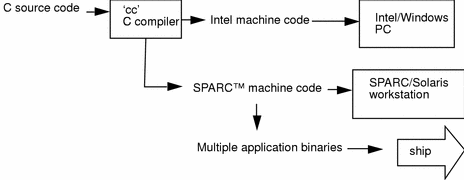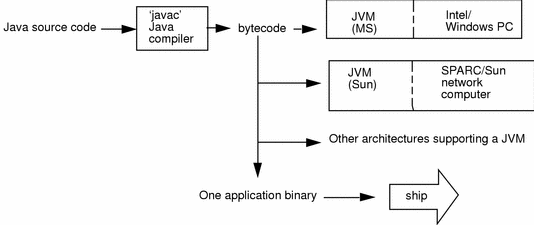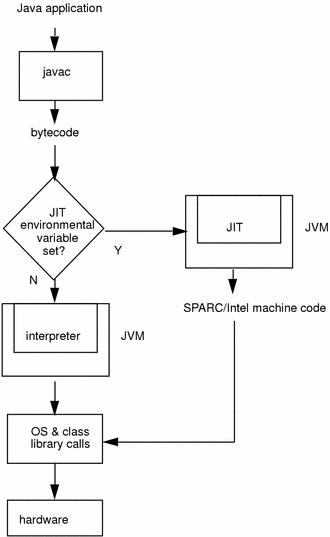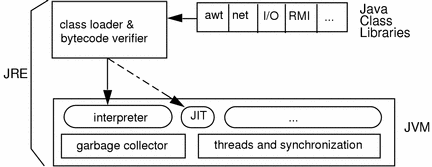Chapter 1 Introduction
This Developer's Guide describes features of and information about application development using Java in the Solaris 2.6 and Solaris 7 environments.
Note -
For important information about this release of Java on Solaris software, refer to
http://www.sun.com/solaris/java/
Java And The Java Runtime Environment (JRE)
This section describes basic information about Java and the JRE.
Java
Java is a recently-developed, concurrent, class-based, object-oriented programming and runtime environment, comprised of:
-
A programming language
-
An API specification
-
A virtual machine specification
Java has the following characteristics:
-
Object-oriented. Java provides the basic object technology of C++ with some enhancements and some deletions.
-
Architecture-neutral. Java source code is compiled into architecture-independent object code. The object code is interpreted by a Java Virtual Machine (JVM) on the target architecture.
-
Portable. Java implements additional portability standards. For example, ints are always 32-bit, 2's-complemented integers. User interfaces are built through an abstract window system that is readily implemented in Solaris and other operating environments.
-
Distributed. Java contains extensive TCP/IP networking facilities. Library routines support protocols such as HyperText Transfer Protocol (HTTP) and file transfer protocol (FTP).
-
Robust. Both the Java compiler and the Java interpreter provide extensive error checking. Java manages all dynamic memory, checks array bounds, and other exceptions.
-
Secure. Features of C and C++ that often result in illegal memory accesses are not in the Java language. The interpreter also applies several tests to the compiled code to check for illegal code. After these tests, the compiled code causes no operand stack over- or underflows, performs no illegal data conversions, performs only legal object field accesses, and all opcode parameter types are verified as legal.
-
High-performance. Compilation of programs to an architecture independent machine-like language, results in a small efficient interpreter of Java programs. The Java environment also compiles the Java byte code into native machine code at run time.
-
Multithreaded. Multithreading is built into the Java language. It can improve interactive performance by allowing operations, such as loading an image, to be performed while continuing to process user actions.
-
Dynamic. Java does not link invoked modules until run time.
-
Simple.It is similar to C++, but with most of the more complex features of C and C++ removed.
Java does not provide:
-
Programmer-controlled dynamic memory
-
Pointer arithmetic
-
struct
-
typedefs
-
#define
-
JRE
The JRE is the software environment in which programs compiled for a typical JVM implementation can run. The runtime system includes:
-
The code necessary to run Java programs, dynamically link native methods, manage memory, and handle exceptions.
-
An implementation of the JVM.
This figure shows the JRE and its components, including a typical JVM implementation's various modules and its functional position with respect to the JRE and class libraries.
Figure 1-1 Typical JVM's Implementation: Functional Relationship to JRE and Class Libraries

JVM
The JVM is an abstract computing machine, having an instruction set and using memory. Virtual machines are often used to implement a programming language. The JVM is the cornerstone of the Java programming language. It is responsible for Java's cross-platform portability and the small size of its compiled code.
The Solaris JVM is used to execute Java applications. The Java compiler, javac, outputs bytecodes and puts them into a .class file. The JVM then interprets these bytecodes, which can then be executed by any JVM implementation, thus providing Java's cross-platform portability. The next two figures illustrate the traditional compile-time environment and the new portable Java compile-time environment.
Figure 1-2 Traditional Compile-Time Environment

Figure 1-3 New Portable Java Compile-Time Environment

The MT JVM
The Java programming language requires that MT programs be supported. All Java interpreters provide an MT programming environment. However, many of these interpreters support only uniprocessor multithreading, so Java program threads are executed only one at a time.
The Solaris JVM interpreter takes full advantage of multiprocessor systems by using the intrinsic Solaris multithread facilities. These allow multiple threads of a single process to be scheduled simultaneously onto multiple CPUs. An MT Java program run under the Solaris JVM will have a substantial increase in concurrency over the same program run on other platforms.
The Sun Just-In-Time(JIT) Compiler
The Sun Java JIT compiler, an integral part of the Solaris JVM, can accelerate execution performance many times over previous levels. Long-running, compute-intensive programs show the best performance improvement.
The JIT Compile Process
When the JIT compiler environment variable is on (the default), the JVM reads the .class file for interpretation and passes it to the JIT compiler. The JIT compiler then compiles the bytecodes into native code for the platform on which it is running. The next figure illustrates the JIT compile process.
Figure 1-4 JIT Compile Process

The following figure shows the functional relationship of the JIT to the Solaris JVM and JRE.
Figure 1-5 Solaris JVM Functional Relationship to the JIT Compiler

- © 2010, Oracle Corporation and/or its affiliates
